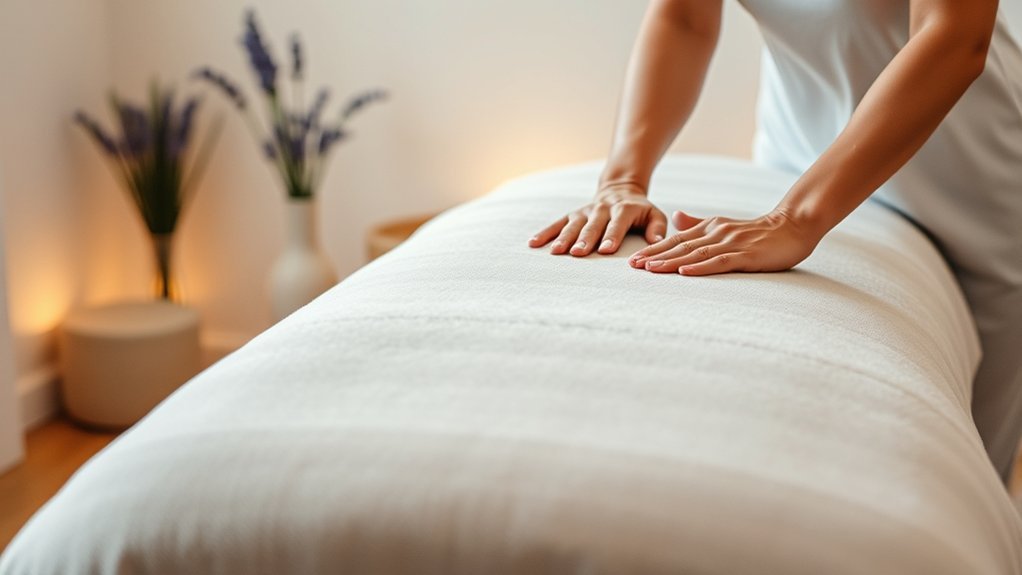Perineal massage can play a significant role in reducing the risk of tearing during childbirth. Starting this practice around 34 weeks of pregnancy can help prepare your body for the birthing process. It’s all about finding a comfortable routine that works for you. As you explore this technique, understanding the right approach is essential for effectiveness and comfort. Let’s look at how to get started and what to keep in mind for a positive experience.
Understanding Perineal Massage and Its Benefits

While you might feel a bit apprehensive about perineal massage, it can offer significant benefits during pregnancy. This gentle technique helps prepare your perineum for childbirth by increasing elasticity and reducing the risk of tearing.
By incorporating perineal massage into your routine, you may also promote relaxation and a sense of connection with your body. Many women find that it eases discomfort in their pelvic area, fostering a positive mindset as they approach labor.
Plus, the practice encourages mindfulness, allowing you to focus on breathing and your baby’s movements. Remember, every woman’s experience is unique, so listen to your body and go at your own pace.
Embracing perineal massage can ultimately enhance your birthing experience, making it feel more empowering and manageable.
When to Start Perineal Massage

Knowing when to start perineal massage can make a big difference in your preparation for childbirth.
It’s generally recommended to begin around 34 weeks of pregnancy, focusing on regular sessions to help ease tension and improve elasticity.
We’ll discuss how often to practice and for how long, so you can feel confident and ready.
Optimal Timing for Massage
Starting perineal massage at the right time can make a significant difference in your birthing experience.
Ideally, you should begin around 34 weeks of pregnancy. This allows your body enough time to adapt and respond positively to the technique. By starting early, you’ll help increase flexibility in the perineal area, which may ease the stretching during delivery.
Remember, it’s important to listen to your body and approach the massage gently. If you feel any discomfort, it’s okay to pause or adjust your technique.
Always consult your healthcare provider if you have any concerns or questions. They can offer guidance tailored to your unique situation, ensuring you feel supported and prepared as you approach labor.
Frequency and Duration Guidelines
To maximize the benefits of perineal massage, aim for a frequency of about three to four times a week, with each session lasting around 5 to 10 minutes.
Starting around the 34th week of pregnancy is ideal, as it allows your body to adjust and prepares your perineum for childbirth. Consistency is key, so try to set aside a regular time that works for you.
Keep in mind that everyone’s body is different; you might need to adjust your routine based on comfort levels. Listen to your body and don’t hesitate to take breaks if you feel any discomfort.
How to Perform Perineal Massage: Step-by-Step Guide

Perineal massage can be a valuable practice for expectant parents looking to ease childbirth and promote comfort.
Start by washing your hands and finding a comfortable position, either lying down or sitting. Apply a small amount of lubricant, like olive oil or a water-based gel, to your fingers and the perineal area.
Using your thumbs, gently press down and outward, stretching the perineum. Focus on applying gentle pressure for about 1-2 minutes. You can gradually increase the intensity as you become more comfortable.
Remember to breathe deeply and relax your body; this’ll help you connect with the area. Aim to practice this a few times a week leading up to your due date for the best results.
Tips for Making Perineal Massage Comfortable
While preparing for perineal massage, creating a comfortable environment is key to making the experience more enjoyable.
Start by finding a quiet, private space where you feel relaxed and at ease. Dim the lights and play soft music if it helps you unwind.
Ascertain your body is warm; a cozy blanket or warm compress can help with that. You’ll want to use plenty of lubricant, as this can reduce discomfort and allow for smoother movements.
Take your time and breathe deeply to help your body relax. If you feel any discomfort, it’s okay to stop and adjust your technique or position.
Common Mistakes to Avoid During Perineal Massage
When practicing perineal massage, it’s essential to avoid common mistakes that can hinder your experience.
Using improper techniques or not maintaining a consistent practice schedule can lead to discomfort and lessen the benefits.
Improper Technique Usage
Improper technique during perineal massage can lead to discomfort and reduce its effectiveness, so it’s essential to be aware of common mistakes. Here are some key points to keep in mind:
| Mistake | Description | Effect |
|---|---|---|
| Ignoring Relaxation | Not taking time to relax beforehand | Increased tension, pain |
| Using Too Much Pressure | Applying excessive force | Discomfort, potential injury |
| Inconsistent Movements | Failing to maintain a steady rhythm | Ineffective massage, stress |
Inconsistent Frequency Practice
Regular practice of perineal massage is essential for maximizing its benefits, yet many overlook the importance of consistency. If you only practice sporadically, you mightn’t see the results you’re hoping for.
Aim to incorporate perineal massage into your routine several times a week, ideally starting in the third trimester. This consistent approach helps to increase elasticity and reduce the risk of tearing during childbirth.
It’s understandable to feel overwhelmed, but remember that even a few minutes dedicated to this practice can make a difference. Set reminders or pair it with another routine activity to help establish the habit.
Incorporating Perineal Massage Into Your Prenatal Routine
Incorporating perineal massage into your prenatal routine can be a simple yet effective way to prepare your body for childbirth. Start around 34 weeks, setting aside a few minutes a few times a week.
Find a comfortable position, whether sitting or lying down. Use a natural oil, like almond or coconut oil, to reduce friction. Gently stretch the perineum by applying pressure with your fingers, moving in a U-shape.
Listen to your body; it should feel gentle and not painful. This practice can help increase elasticity and reduce tearing during delivery.
Frequently Asked Questions
Can Perineal Massage Be Performed During Menstruation?
Yes, you can perform perineal massage during menstruation. Just make sure you’re comfortable and hygienic. If you’re feeling crampy or sensitive, it might be best to wait until your period’s over. Listen to your body’s needs.
Is Perineal Massage Safe for High-Risk Pregnancies?
It’s best to avoid perineal massage during high-risk pregnancies. Consult your healthcare provider first; they’ll guide you on safe practices tailored to your situation. Your safety and your baby’s health are the top priorities.
What Products Are Recommended for Perineal Massage?
For perineal massage, try using natural oils like coconut or almond oil. They’re gentle and moisturizing. Always guarantee the products are safe for your skin and consult your healthcare provider if you have concerns.
Can Partners Assist With Perineal Massage?
“Many hands make light work.” Yes, your partner can definitely assist with perineal massage. Their support can create a comfortable environment, fostering intimacy while helping you prepare for labor. Communication and trust are key during this process.
How Often Should Perineal Massage Be Practiced?
You should practice perineal massage regularly, ideally three to four times a week, starting around 34 weeks of pregnancy. Consistency helps increase flexibility and may reduce discomfort during delivery, so be gentle and patient with yourself.
Conclusion
Incorporating perineal massage into your prenatal routine can greatly reduce the risk of tearing during childbirth. Research shows that women who practice perineal massage may experience a 30% lower chance of needing an episiotomy. By starting around 34 weeks and focusing on relaxation, you’re taking a proactive step for a smoother delivery. Remember to listen to your body and consult your healthcare provider for personalized advice. You’re not alone on this journey; supportive resources are here for you.
